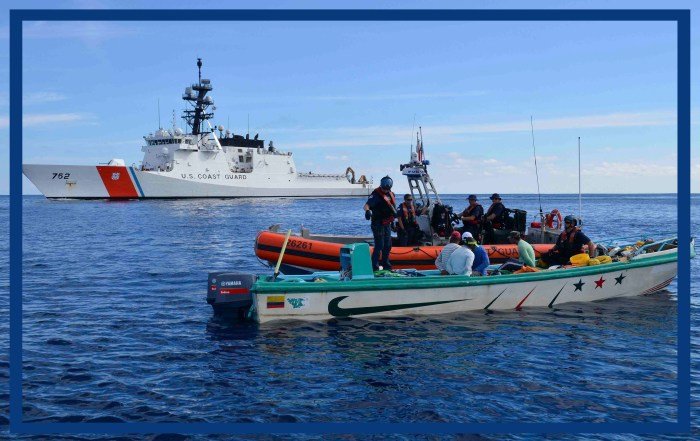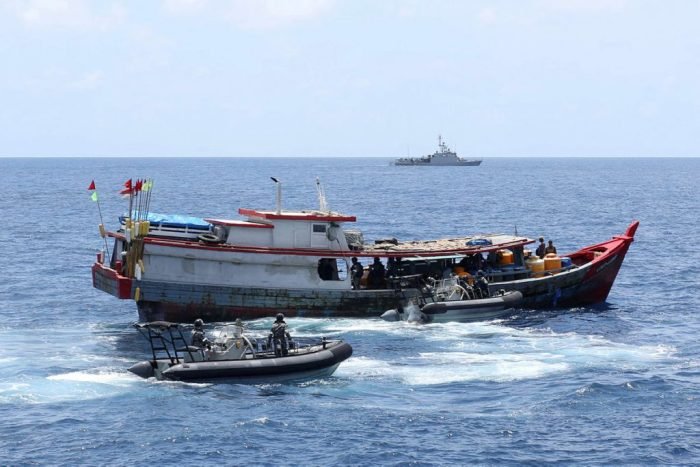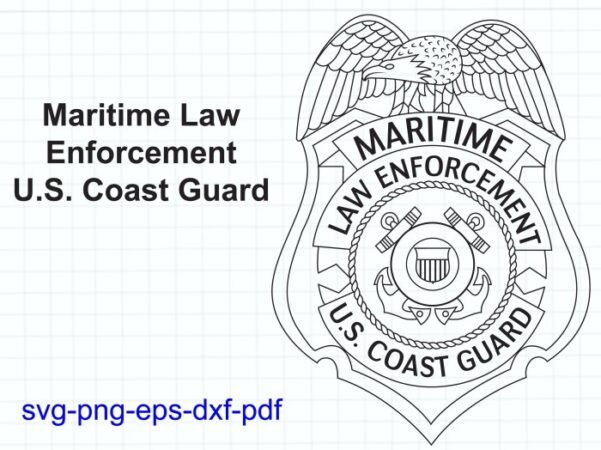
-
USCG Law Enforcement Operations
- Types of USCG Maritime Law Enforcement Operations
- Methods and Procedures Used During Boardings and Inspections
- Examples of Successful USCG Maritime Law Enforcement Operations
- Steps Involved in a Typical USCG Boarding Operation
- Specialized Equipment and Technologies Used by USCG Law Enforcement Personnel
-
Challenges and Future Trends in USCG Maritime Law Enforcement
- Evolving Threats to Maritime Security and Their Impact on USCG Operations
- Technological Advancements Influencing USCG Maritime Law Enforcement
- Challenges Posed by Cybercrime and Data Breaches in Maritime Security
- Innovative Strategies Implemented by the USCG to Address Challenges
- Potential Future Trends in USCG Maritime Law Enforcement
- USCG Training and Personnel
- Ending Remarks
- FAQ Overview
The United States Coast Guard (USCG) plays a vital role in safeguarding America’s maritime interests. Beyond its well-known search and rescue missions, the USCG is a powerful maritime law enforcement agency, responsible for upholding the law across vast stretches of ocean and coastline. This exploration delves into the multifaceted world of USCG maritime law enforcement, examining its jurisdiction, operations, legal framework, and the challenges it faces in an ever-evolving maritime landscape.
From combating drug smuggling and illegal immigration to enforcing environmental regulations and ensuring the safety of maritime commerce, the USCG’s responsibilities are extensive and complex. This overview will examine the agency’s authority, its operational methods, the legal basis for its actions, and the international collaborations crucial to its success. We will also consider the future challenges facing the USCG, including emerging threats and technological advancements.
USCG Law Enforcement Operations
The United States Coast Guard (USCG) plays a crucial role in maritime law enforcement, ensuring the safety and security of U.S. waters and protecting national interests. Its broad mandate encompasses a wide range of operations, each demanding specialized skills and resources. This section details the diverse operational areas, methods, and successes of the USCG in maintaining maritime order.
Types of USCG Maritime Law Enforcement Operations
The USCG’s law enforcement responsibilities are multifaceted. They actively engage in drug interdiction, disrupting the flow of illegal narcotics through maritime routes. Migrant smuggling interdiction is another key area, focusing on preventing the dangerous and often illegal transport of people across international waters. Fisheries enforcement ensures compliance with fishing regulations, protecting marine ecosystems and the livelihoods of legitimate fishermen. Beyond these core areas, the USCG also enforces environmental protection laws, conducts search and rescue operations (often involving law enforcement aspects), and assists in port security and counterterrorism efforts. These operations often overlap and require coordinated responses.
Methods and Procedures Used During Boardings and Inspections
USCG boardings and inspections are governed by established procedures to ensure safety and legality. Before a boarding, the Coast Guard typically identifies a vessel of interest through observation, intelligence, or other means. Once a decision to board is made, a team, usually composed of several officers, approaches the vessel in a safe and professional manner. They identify themselves, state their purpose, and request permission to board. If permission is refused or there is reasonable suspicion of illegal activity, the Coast Guard has the authority to board the vessel. Once on board, a thorough inspection is conducted, checking documentation, cargo, and the vessel’s condition. Evidence of illegal activity is documented meticulously, adhering to strict chain-of-custody procedures. The boarding team may utilize specialized equipment (discussed later) to assist in the inspection process. Throughout the process, the safety and well-being of both the boarding team and the vessel’s crew are paramount.
Examples of Successful USCG Maritime Law Enforcement Operations
The USCG has a long history of successful operations. In one notable example, a large-scale drug interdiction operation resulted in the seizure of several tons of cocaine and the arrest of numerous individuals involved in drug trafficking. This operation involved intelligence gathering, surveillance, and coordinated efforts with other agencies. Another success story involves the interdiction of a migrant smuggling vessel attempting to transport a large number of individuals illegally. This operation highlighted the USCG’s commitment to humanitarian efforts while enforcing immigration laws. The challenges in these operations often include adverse weather conditions, the dangerous nature of the criminal activity involved, and the need for effective international cooperation. The outcomes typically involve the seizure of contraband, the arrest of suspects, and the disruption of criminal networks.
Steps Involved in a Typical USCG Boarding Operation
The following flowchart illustrates a typical USCG boarding operation:
[Descriptive Flowchart]
Start -> Vessel Selection/Identification -> Approach Vessel -> Request Permission to Board -> Permission Granted (Proceed to Inspection) / Permission Denied (Legal Justification for Boarding Required) -> Boarding Conducted -> Inspection & Evidence Collection -> Documentation -> Vessel Release/Arrest -> Report Filing -> End
This flowchart simplifies the process; variations occur depending on the specific circumstances.
Specialized Equipment and Technologies Used by USCG Law Enforcement Personnel
The USCG utilizes a wide array of specialized equipment and technologies to effectively conduct maritime law enforcement operations. This includes advanced sensors for detecting contraband, such as radar and thermal imaging systems. High-speed patrol boats and helicopters provide rapid response capabilities. Specialized diving equipment enables underwater searches and inspections. Non-lethal weapons, such as tasers and pepper spray, are employed to ensure safety during boardings. Communication systems facilitate seamless coordination among teams and with other agencies. Finally, advanced data analysis tools help identify patterns and trends in criminal activity, supporting proactive enforcement strategies. The use of these technologies significantly enhances the effectiveness and safety of USCG operations.
Challenges and Future Trends in USCG Maritime Law Enforcement

The US Coast Guard’s (USCG) maritime law enforcement mission faces an increasingly complex and dynamic threat landscape. Maintaining security and order on the nation’s waterways requires adaptability, technological innovation, and strategic foresight to counter evolving challenges. The following sections delve into the key obstacles and emerging trends shaping the future of USCG maritime law enforcement.
Evolving Threats to Maritime Security and Their Impact on USCG Operations
Maritime security threats are constantly evolving, demanding a proactive and adaptable response from the USCG. Traditional threats like drug smuggling and human trafficking persist, but are now often intertwined with sophisticated criminal networks leveraging advanced technologies. The rise of transnational organized crime, utilizing fast, agile vessels and encrypted communication, presents significant challenges to interdiction efforts. Furthermore, the potential for terrorist attacks targeting maritime infrastructure or passenger vessels necessitates robust security measures and intelligence gathering. These evolving threats necessitate increased collaboration with international partners, improved intelligence sharing, and the deployment of advanced technologies to enhance surveillance and response capabilities. For example, the increase in sophisticated smuggling techniques, such as using semi-submersible vessels, requires the USCG to adapt its detection and interdiction strategies, potentially investing in new technologies like underwater drones or advanced radar systems.
Technological Advancements Influencing USCG Maritime Law Enforcement
Technological advancements are profoundly impacting USCG maritime law enforcement. The integration of unmanned aerial vehicles (UAVs, or drones), providing real-time surveillance and reconnaissance capabilities, enhances situational awareness and aids in search and rescue operations. Advanced sensor technologies, including high-resolution radar and thermal imaging, improve detection capabilities for illicit activities. Data analytics and artificial intelligence (AI) are being utilized to analyze vast amounts of data, identifying patterns and predicting potential threats. The development and implementation of these technologies, however, require significant investment in training and infrastructure to ensure effective utilization and integration within existing operational frameworks. For instance, the use of AI in analyzing maritime traffic data can help predict potential smuggling routes or identify suspicious vessel behavior, allowing for more proactive and efficient deployment of resources.
Challenges Posed by Cybercrime and Data Breaches in Maritime Security
Cybercrime poses a significant and growing threat to maritime security. Attacks targeting critical maritime infrastructure, such as port facilities or navigation systems, could have catastrophic consequences. Data breaches targeting sensitive information, including vessel manifests or crew details, can compromise operational security and facilitate illicit activities. The interconnected nature of modern maritime systems makes them vulnerable to cyberattacks, requiring robust cybersecurity measures to protect against intrusions and data theft. The USCG is actively working to enhance cybersecurity protocols and training programs to mitigate these risks. For example, a successful cyberattack on a port’s automated container tracking system could disrupt operations, causing significant economic losses and potentially creating security vulnerabilities.
Innovative Strategies Implemented by the USCG to Address Challenges
The USCG is actively implementing innovative strategies to address the evolving challenges in maritime law enforcement. Increased collaboration with international partners enhances intelligence sharing and coordinated enforcement efforts against transnational crime. The use of predictive policing techniques, leveraging data analytics to identify high-risk areas and potential threats, allows for more efficient resource allocation. Investment in advanced training programs ensures personnel possess the skills and knowledge to effectively utilize new technologies and respond to emerging threats. The development of specialized units, such as cyber security teams, focuses expertise on addressing specific threats. For instance, the USCG’s participation in international maritime security exercises allows for the sharing of best practices and the development of coordinated responses to common threats.
Potential Future Trends in USCG Maritime Law Enforcement
The future of USCG maritime law enforcement will be shaped by several key trends:
- Increased reliance on artificial intelligence and machine learning for threat detection and predictive policing.
- Greater integration of unmanned systems (drones, autonomous vessels) into operations.
- Enhanced cybersecurity measures to protect critical maritime infrastructure and data.
- Expansion of international partnerships and collaborative enforcement efforts.
- Development of new technologies for detecting and interdicting advanced smuggling techniques.
- Focus on environmental protection and combating illegal activities impacting marine ecosystems.
USCG Training and Personnel

The United States Coast Guard (USCG) boasts a highly trained and specialized law enforcement workforce. Rigorous training programs and a structured organizational hierarchy ensure personnel are equipped to handle the diverse challenges inherent in maritime law enforcement. The effectiveness of the USCG’s operations is directly linked to the quality and preparedness of its personnel.
USCG law enforcement personnel undergo extensive training encompassing a broad range of skills. This training extends beyond basic law enforcement procedures to incorporate specialized maritime knowledge and techniques. The intensity and duration of training varies depending on the specific role and responsibilities within the organization.
USCG Law Enforcement Training Programs
The USCG employs a multi-faceted approach to training, incorporating classroom instruction, hands-on exercises, and realistic simulations. Initial training for prospective law enforcement officers typically includes a comprehensive curriculum covering maritime law, search and rescue techniques, vessel boarding procedures, evidence collection and preservation, and the use of specialized equipment. Specialized training modules focus on areas such as drug interdiction, counterterrorism, and port security. Ongoing professional development ensures personnel remain current with evolving laws, technologies, and best practices. Recurrent training emphasizes maintaining proficiency in critical skills and adapting to emerging threats. Examples of this include advanced tactical training for boarding teams and specialized courses in cybersecurity and maritime intelligence.
Organizational Structure and Hierarchy
The USCG’s law enforcement branch is structured hierarchically, with clear lines of authority and responsibility. The organizational structure mirrors the overall Coast Guard structure, with various levels of command and control. At the operational level, teams are led by experienced officers who oversee day-to-day operations and supervise subordinate personnel. These teams typically consist of various specialists, each contributing their unique skills and expertise. Above the operational level, regional and national commands provide strategic direction and oversight. This hierarchical structure ensures efficient coordination and response to incidents across the wide-ranging responsibilities of the USCG.
Role of Specialized Units
Specialized units within the USCG play crucial roles in enhancing the overall effectiveness of maritime law enforcement. The Coast Guard Investigative Service (CGIS), for instance, is responsible for conducting complex criminal investigations related to maritime violations. Their investigations often involve significant financial crimes, smuggling, and environmental violations, requiring specialized investigative skills and legal expertise. Other specialized units focus on areas such as counterterrorism, port security, and drug interdiction, each requiring unique training and expertise. These specialized units collaborate closely with other law enforcement agencies and international partners to address transnational crime and security threats.
Typical Career Path for a USCG Law Enforcement Officer
A typical career path for a USCG law enforcement officer might begin with entry-level positions after completing initial training. Progression through the ranks is generally based on performance, experience, and completion of advanced training programs. Officers may specialize in particular areas, such as investigations, maritime safety, or port security, further advancing their career within those chosen fields. Opportunities for leadership roles and command positions become available with increasing experience and seniority. The career progression often involves increasing responsibility and the opportunity to lead and mentor junior officers.
Roles and Responsibilities During a Typical Operation
During a typical operation, a USCG law enforcement team may comprise various specialists, each with defined roles and responsibilities. A team leader coordinates the operation, ensuring adherence to safety protocols and legal procedures. Boarding officers conduct the actual boarding of vessels, while other team members might focus on evidence collection, documentation, and communication. Specialized personnel may be deployed depending on the nature of the operation, such as a diver for underwater inspections or a canine unit for detecting contraband. Effective teamwork and clear communication are essential for the successful completion of operations, ensuring both safety and legal compliance.
Ending Remarks

The USCG’s maritime law enforcement mission is critical to national security and economic prosperity. Its vast responsibilities require a highly skilled and adaptable workforce, constantly evolving its tactics and technology to meet new challenges. From the open ocean to the nation’s harbors, the Coast Guard’s vigilance safeguards our waterways and protects our interests, highlighting the vital importance of its continued dedication and resources.
FAQ Overview
What is the difference between the USCG and the Navy?
The US Navy focuses on national defense and projecting power globally, while the USCG is a federal maritime service with a broader focus including law enforcement, search and rescue, and maritime safety.
Can the USCG board a private vessel in international waters?
The USCG’s authority in international waters is limited and depends on factors like treaties, flag state consent, and suspicion of criminal activity. They typically require probable cause.
What types of crimes does the USCG investigate?
The USCG investigates a wide range of maritime crimes, including drug trafficking, smuggling (human and goods), illegal fishing, environmental violations, and vessel safety violations.
How can I report a maritime crime to the USCG?
Maritime crimes can be reported to the USCG through various channels, including their online reporting systems, local Coast Guard stations, or through other law enforcement agencies.


